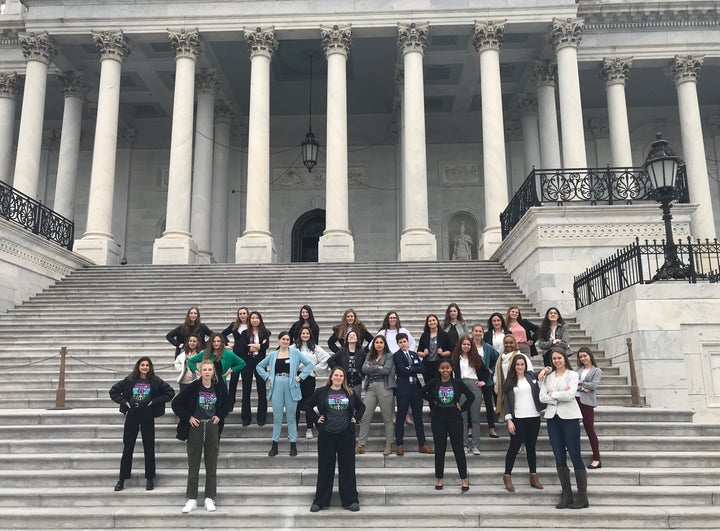
There’s a new generation fighting for an old cause: Young women descended on the Dirksen Senate Office Building on Wednesday looking to rally support for the Equal Rights Amendment, which would finally codify women’s rights in the Constitution.
“I’m missing a math quiz today,” said Belan Yeshigeta, a 16-year-old student from Arlington, Virginia, who called in sick to come to Washington on a school day.
The co-founder of an activist group called Generation Ratify, Yeshigeta was with about 60 other high school and college students from all over the country. They were from groups like GenZ Girl Gang, Girl Up, Period and DC Teens Action, with organizing help from Platform women. And the girls ― plus three boys and one nonbinary teen ― were there to talk to senators about the ERA.
The amendment just this month cleared the threshold needed for ratification and inclusion in the Constitution. At least some people think it did.
One problem: The amendment they’re fighting for was just pronounced dead by some, thanks to remarks on Monday by Supreme Court justice and longtime women’s rights advocate Ruth Bader Ginsburg about the potential need to start from scratch to get it added to the Constitution.
But the ERA isn’t actually dead yet. On Thursday, the House passed a bill that would eliminate the deadline for ratification.
And young activists aren’t ready to give up.
“Whether what we do will make a difference is unknown,” Yeshigeta said, adding, “It’s important we try.” She mentioned they had printed out packets with talking points for all the members of the group, most of them first-timers at this sort of thing.
Women have been trying to get the ERA over the finish line for nearly a century, since the amendment was first conceived in 1923. The process has been halting, to put it mildly. The amendment passed Congress with wide majorities in 1972. The path to ratification ― requiring passage in three-fourths of state legislatures ― looked solid as a flurry of states got on board.
Then, a backlash. Dire warnings from anti-feminists about the abandonment of housewives, women getting drafted and gay marriage sent the process into a morass of misinformation and panic. (An amendment would simply state that no one should be discriminated against on the basis of sex; interpretations would have to be worked out in the courts and Congress.)
Only 35 states had ratified the ERA by 1982, a deadline imposed on the process by Congress. That was three states short of what was needed to amend the constitution.
For decades, the ERA was considered dead.
Then, just a few years ago, activists started pushing again to get the remaining three states needed to ratify the amendment. And, it worked. Earlier this year, Virginia became the 38th state to ratify, clearing the hurdle needed to amend the Constitution.
But there’s a problem: that deadline. Opponents of the amendment, including Donald Trump’s Justice Department, say the ratification process ended in 1982. The DOJ has come out against the current push.

Even Ginsburg, a champion of women’s rights, said in a talk Monday that probably the best path forward for the ERA would be to go back to the beginning and restart the whole ratification process.
Virginia’s ratification came long after the deadline had passed, Ginsburg said in a talk at Georgetown University. “I’d like it to start over,” she said.
But Ginsburg’s not running this show. The House is continuing to press forward with a bill that would eliminate the deadline. Although the chances of the Senate voting to do the same are slim, young activists are hopeful.
“The Senate is having a bit of a values crisis,” is how Yeshigeta, the high schooler, put it.
She and her peers met with about 14 Senate offices on Wednesday. No lawmakers attended, but Yeshigeta and her classmate and co-founder Rosie Couture spoke to staffers in each office.
Opposition to the ERA, they reported, mostly fell along party lines.
But the resistance to the amendment had little to do with the deadline. They were told that the ERA was a no-go because it would legalize abortion. It’s already legal, of course. Conservative Senate staffers also seemed anxious that a prohibition on sex discrimination would mean rights for transgender people; they weren’t really informed on the issue. “Not a lot of people know what the ERA is,” said Couture.
That was heartening in a way, said Yeshigeta: “It does kind of show, if we are able to educate enough people, it’s definitely going to happen.”
“I’m not as optimistic,” Couture countered.
Yeshigeta, like many ERA supporters, remains confident they will get it done.
The ERA has “been hanging on for dear life for so long,” she said. “I’m glad we’ll be part of the generation to see it through."
